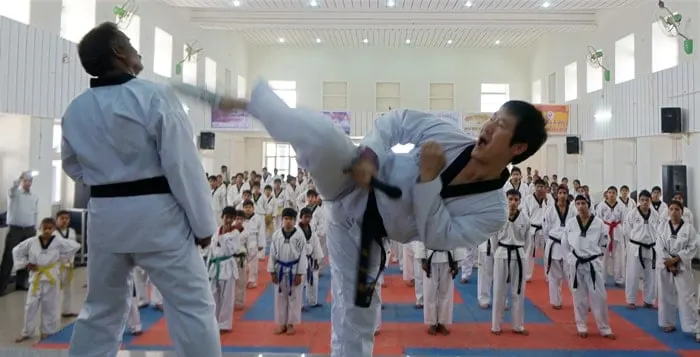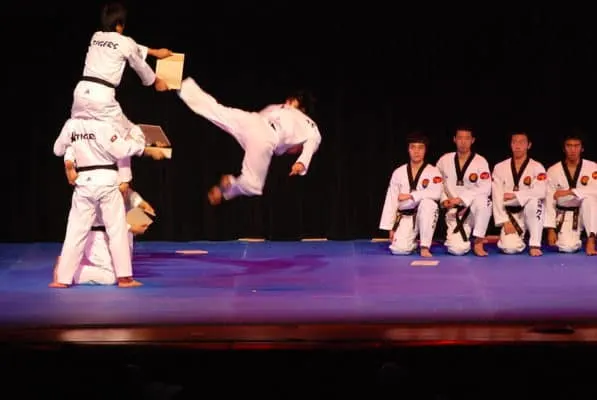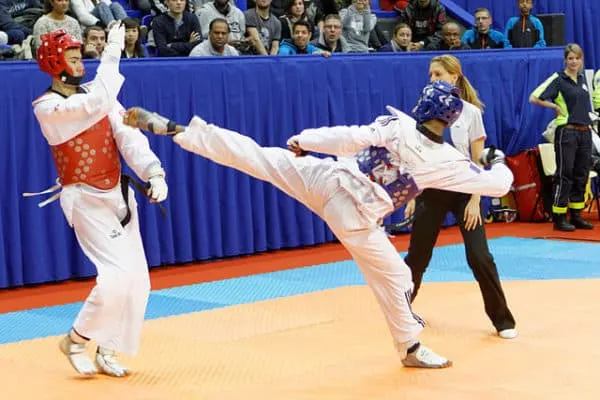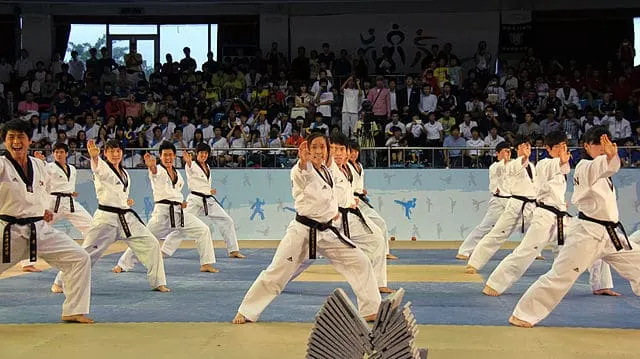
Taekwondo(TKD) is a well-recognized sport in competitions across the world, including the Olympic Games and MMA. However, these competitions each have their own rules, raising the question of whether or not Taekwondo is effective in a real fight. This article will explore Taekwondo as self-defense in real-life situations, where there are no rules or points.
Taekwondo can be effective in a fight due to its kicking accuracy and power. However, the major problem with Taekwondo as self-defense is that it does not prepare you for the fight on the ground, where many fights occur.
I will explain in more detail why I think Taekwondo on its own will not prepare you for a real fight. I have also included examples of Taekwondo used in MMA and its advantages and disadvantages.
Is Taekwondo Effective for Self-Defense?
Training in Taekwondo will provide you with some knowledge of offense and defense that you can still use in a fight. However, this should not be considered an effective discipline for self-defense. Overall, Taekwondo has become more about performing elaborate kicks to score points in a competition setting, which I will explain further down.
These elaborate kicks, although powerful, will waste much-needed time and energy that could cost you greatly when faced with an attacker. Any kicks leave you at greater risk of being thrown off balance and being hit by your opponent.

Taekwondo also focusses heavily on standing fights, whereas many fights in reality are taken to the ground. When on the ground, the kick and hand strikes that are taught in Taekwondo are no longer effective and you could easily be overcome by your attacker. Therefore, you need experience in another fighting style to be fully equipped for any situation.
Is Taekwondo Kick Only?
Despite popular belief, the art of Taekwondo includes more than just kicks. TKD includes hand strikes, blocks, and various self-defense techniques, such as pressure points, throws, joint locks, chokes, and freeing techniques (escapes).
The reason many people believe Taekwondo is a kicking sport is that most Taekwondo competitors will use kicks to gain the most points in a match. Competitors will only earn one point for striking the body, but will earn three points for kicking their opponent in the head. A spinning kick to the torso will also earn two points.

In addition to this, competitors are not allowed to punch their opponent’s head. They will lose points if they punch the face, grab, hold or push their opponent. Therefore, in order to gain the most points and to maintain those points throughout the match, most Taekwondo practitioners will focus on kicks.
What are the Disadvantages of Taekwondo?
You Can’t Simulate a Real Fight
One disadvantage in Taekwondo is that the rules surrounding competition and practice do not allow practitioners to experience real-life threats during a fight. For example, within a controlled environment, your opponent is not allowed to grab and hold onto your leg. In a real fight, someone could catch the leg, throw you off balance and take the fight to the ground.
Taekwondo also does not focus on ground grappling techniques, making practitioners vulnerable if an attacker were to knock them to the ground. In the competition setting, competitors cannot be held down if they fall, allowing them to scramble to their feet again.
They also have 10 seconds to get up before the knockdown is considered a knockout. Therefore, the sport does not encourage ground fighting. Realistically, if you were knocked to the ground by an attacker, they would try to keep you there by kicking, punching or jumping on top of you.
Students May Become Overconfident
It is natural to think that a black belt in Taekwondo would win in a fight. However, as mentioned above, there are situations in a street fight that are not simulated in Taekwondo practice or competitions. This can give practitioners a false sense of security when faced with a real attacker. Someone who genuinely wants to hurt you will not fight within the rules of the Taekwondo match.
As I mentioned earlier, Taekwondo includes some self-defense moves, but these are only practiced in a controlled setting and are only used in competitions as demonstrations. Techniques such as the ‘Scissor Finger’ are designed to gauge at your opponent’s eyes, but practitioners will never have the opportunity to practice this to its full extent in training.
In addition to this, black belts can be awarded to children. On average, it takes approximately four years to reach the black belt level. Therefore, if children begin at an early age, they have the potential to reach their black belt before they are 10 years old. With these children learning alongside their adult peers, they may naively think that they can defend themselves effectively against a fully grown adult.
One of the youngest children to earn their Taekwondo black belt was Ethan Comer, who was promoted at six years old. Although Comer would have a better chance at defending himself against an attacker than other children, he realistically will not be effective against an adult who could use their size and strength against him.
Most Gyms are Competition-Focussed
Although there are some effective self-defense strategies in Taekwondo, most of these are not permitted in a competition setting. As I mentioned before, eye-gouging is a method that is included in the list of Taekwondo techniques, but this will lead to disqualification and serious harm to your opponent/peer.
Because of this, many gyms (or Dojangs) will focus primarily on what will earn their students the most points in competitions; kicks.
Is Taekwondo a Good Martial Art?
Among its disadvantages, Taekwondo is still beneficial to those that choose to learn the art. As with any sport, training in Taekwondo can help to keep you fit and healthy and improves your flexibility considerably.
Taekwondo specifically will train you to strike quickly and with accuracy when kicking your opponent. These kicks can expend energy in a fight, but if the opportunity presents itself, a well-timed and well-placed kick can knock your attacker out.
However, there are still gaps in knowledge that leave you vulnerable in a fight. Even if you learn Taekwondo techniques such as hand striking, escapes, throws, chokes and joint locks, you still will not be prepared for a ground fight.
On the ground, your kicking techniques and most of the hand strikes are not possible, ruling out most of your offensive attacks. Even if the fight remains standing, kicks leave you much more vulnerable to being thrown off balance than staying on both feet and striking with your fists.
Therefore, Taekwondo is better to learn alongside another fighting style, such as Brazilian Jiu Jitsu, boxing or wrestling. By itself, the focus relies heavily on the fight remaining standing.
Is Taekwondo Really Useless?
Taekwondo has its benefits over other martial arts, as mentioned above, but some people believe that its disadvantages render the art useless in the real world. However, learning a martial art is never entirely useless.
Having a martial arts background still gives you an advantage over an untrained attacker. You are taught how to stay calm when faced with an opponent and how to land accurate strikes.
To add to this, you will also develop self-esteem and confidence. Students are taught to respect themselves and others and learn how they should be treated. This can help in everyday life when you need to stand up for yourself to resolve conflict, such as in the workplace.

Martial arts are also very team-focussed, encouraging students to be humble and to support one another. The discipline that comes with learning a martial art is part of the reason why many parents enrol their children in a martial arts school.
Why is Taekwondo Not Respected?
Some people lose respect for a martial art if they feel it has drifted away from its origins and become a ‘watered down’ version of what it once was. This has been the general view of Taekwondo as it has slowly transitioned into a sport governed by organizations such as the World Taekwondo Federation and being included in the Olympics.
The focus has slowly shifted from learning effective offense and defense to learning how to score the most points in a short space of time. Practitioners will learn to ‘tap’ their opponents as they execute perfect kicks. Meanwhile, your opponent is limited in their defense options based on the rules of the sport. They cannot grab you, hold you or attack you below the waist.
Although Taekwondo was traditionally a dangerous and effective means of protecting yourself from an attacker, the rules that govern the sport now have rendered it ineffective in the real world.
Do any MMA Fighters use Taekwondo?
There have been a number of fighters in MMA that have trained in Taekwondo. One example is Anderson Silva, a fifth-dan black belt in Taekwondo. Silver was a UFC Middleweight Champion and still holds the record for the longest-reigning UFC champion, with a total of 2457 consecutive days. Demetrius Johnson holds second place with 2142 days.
Throughout his reign, Silva certainly used many Taekwondo techniques, including a number of impressive knockouts. However, he also holds a black prajied in Muay Thai and a third-degree black belt in Brazilian Jiu Jitsu. He used a combination of techniques from each in his fights.
Another great example of a high-level Taekwondo practitioner in MMA is Anthony Pettis. He holds a third-dan black belt in Taekwondo and was a one-time UFC Lightweight Champion. However, again, Pettis also holds a black belt in BJJ to compliment his Taekwondo techniques.
This demonstrates that successful fighters do use Taekwondo in MMA. However, it also points out that these techniques need to be combined with another discipline in order for a fighter to succeed in a fight.
Is TKD Better Than Karate?
Karate is a martial art that uses whole-body movements, with more balance between hand striking and kicks. Taekwondo, on the other hand, has become more weighted towards elaborate kicks from long-range.
Although Karate offers a broader range of techniques, it still faces the same challenges as Taekwondo. Both do not prepare the student for all fighting situations, such as ground fighting. However, one advantage Taekwondo has over Karate is the ability to attack from further away. Most Karate techniques are only effective from close range, leaving you more vulnerable to attack.
The kicking technique in Taekwondo is also faster, increasing the chances of hitting your opponent. Although many fighters in the UFC have a background in Karate, such as Georges St-Pierre, it is more likely that you will see the fighters using techniques from Taekwondo or other martial arts than from Karate.
Therefore, both Taekwondo and Karate would need to be combined with another martial art in order to be fully effective, but Taekwondo may have more relevance in a fight.
